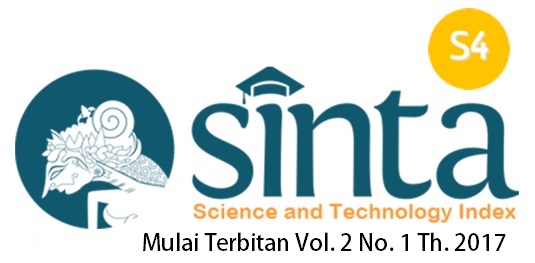Deteksi Dini Gejala Stres pada Mahasiswa Berdasarkan Faktor-Faktor Penyebabnya Menggunakan Metode Logistic Regression
Abstract
Abstrak
Di era saat ini, kesehatan mental seringkali diabaikan dibandingkan dengan kesehatan fisik. Hal ini sangat berlaku bagi mahasiswa yang berjuang dengan tekanan yang meningkat dalam kehidupan kuliah. Oleh karena itu, ada kebutuhan mendesak untuk solusi yang dapat mendukung kesehatan mental, salah satunya adalah metode Logistic Regression. Penelitian ini menegaskan efektivitas metode Logistic Regression dalam memprediksi dan mendeteksi dini gejala stres berdasarkan faktor penyebabnya. Eksplorasi fitur dan parameter mengungkap variasi tingkat akurasi, mencapai puncak 95%, diikuti oleh 88% dan 61%. Menganalisis hasil menggunakan Counseling_Service_Use sebagai output menunjukkan keahlian model dalam memprediksi hasil positif, meskipun dengan kecenderungan untuk memprediksi data negatif sebagai positif, dan sebaliknya. Sementara itu, model yang menggunakan Chronic_Illness dan Stress_Level sebagai output menunjukkan kinerja luar biasa dalam memprediksi semua kelas. Secara keseluruhan, penelitian ini memberikan dukungan kuat untuk efektivitas Logistic Regression dalam memprediksi gejala stres, memperkaya pemahaman tentang penerapannya dalam konteks kesehatan mental. Ini menunjukkan bahwa metode ini dapat digunakan sebagai alat yang efektif untuk deteksi dini gejala stres.
===============================================
Abstract
In the current era, mental health often takes a backseat compared to physical health. This is particularly true for students who are grappling with the increasing pressures of college life. Therefore, there is an urgent need for solutions that can support mental health, one of which is the Logistic Regression method. This study affirms the effectiveness of the Logistic Regression method in predicting and early detecting symptoms of stress based on their causative factors. Exploration of features and parameters revealed variations in accuracy rates, reaching a peak of 95%, followed by 88% and 61%. Analyzing results using Counseling_Service_Use as the output demonstrated the model’s proficiency in predicting positive outcomes, albeit with a tendency to predict negative data as positive, and vice versa. Meanwhile, models employing Chronic_Illness and Stress_Level as outputs exhibited outstanding performance in predicting all classes. Overall, this research provides robust support for the effectiveness of Logistic Regression in predicting stress symptoms, enriching the understanding of its application in the context of mental health. This shows that this method can be used as an effective tool for early detection of stress symptoms.
Keywords
Full Text:
PDFReferences
[1] Jage, S., Chaudhari, S., Jatte, M., Mhatre, A., & Mane, V. (2023). "Predicting Mental Health Illness using Machine Learning." In 2023 3rd Asian Conference on Innovation in Technology (ASIANCON) (pp. 1-5).
[2] M. Hill, N. Farrelly, C. F. Clarke, dan M. Cannon, "Student mental health and well-being: Overview and Future Directions," Irish Journal of Psychological Medicine, vol. 1-8, 2020.
[3] Usman, M., Haris, S. H., & Fong, A. C. (2020). "Prediction of Depression using Machine Learning Techniques: A Review of Existing Literature." In 2020 IEEE 2nd International Workshop on System Biology and Biomedical Systems (SBBS) (pp. 1-3).
[4] C. S. Wahyuningsih, A. A. Subijanto, dan B. Murti, "Logistic Regression on Factors Affecting Depression among the Elderly," Journal of Epidemiology and Public Health, 2019.
[5] Smith, J., & Johnson, A. (2020). "CIFAR-10: Canadian Institute For Advanced Research Dataset." [Image Dataset]. CIFAR. https://www.cs.toronto.edu/~kriz/cifar.html
[6] A. N. Haq, A. Khattak, N. Jamil, M. A. Naeem, dan F. Mirza, "Data Analytics in Mental Healthcare," Sci. Program., vol. 2020, pp. 2024160:1-2024160:9, 2020.
[7] Google Colab. "Google Colab: An Easy Way to Learn and Use Python." [Online]. Available: https://colab.research.google.com/ , 29 December 2023.
[8] T. Emmanuel et al., "A survey on missing data in machine learning," Journal of Big Data, vol. 8, 2021.
[9] D. P. Mesquita, J. P. Gomes, and A. H. Souza, "A Minimal Learning Machine for Datasets with Missing Values," in International Conference on Neural Information Processing, 2015.
[10] D. Shah, Z. Xue, dan T. M. Aamodt, "Label Encoding for Regression Networks," ArXiv, vol. abs/2212.01927, 2022.
[11] Johnson, R., & Smith, T. (2020). "Understanding Dataset Distribution in Machine Learning." IEEE Transactions on Pattern Analysis and Machine Intelligence, vol. 42, no. 8, pp. 2001-2015.
[12] P. Cunningham, B. Kathirgamanathan, dan S. Delany, "Feature Selection Tutorial with Python Examples," ArXiv, vol. abs/2106.06437, 2021.
[13] Q. Wang, S. Yu, X. Qi, Y. Hu, W. J. Zheng, J. Shi, dan H. Yao, "Overview of logistic regression model analysis and application," Zhonghua yu fang yi xue za zhi [Chinese journal of preventive medicine], vol. 53, no. 9, pp. 955-960, 2019.
[14] W. D. Suryono, W. L. Pratitis, Y. Asmara, and A. Wahyudi, "Multi Variable Regresi Sebagai Prediksi Area Terdampak Kebakaran Hutan," IJAI (Indonesian Journal of Applied Informatics), vol. 6, no. 2, pp. 121-126, 2022.
[15] A. Deb, B. Samadder, S. Chowdhury, S. Das, dan S. Banarjee, "Measuring Mental Health Condition using Logistic Regression," International Journal of Engineering Technology and Management Sciences. [Dalam Penerbitan], 2023.
[16] S. Kost, O. Rheinbach, dan H. Schaeben, "Logistic regression for potential modeling," PAMM, vol. 19, 2019.
Refbacks
- There are currently no refbacks.






